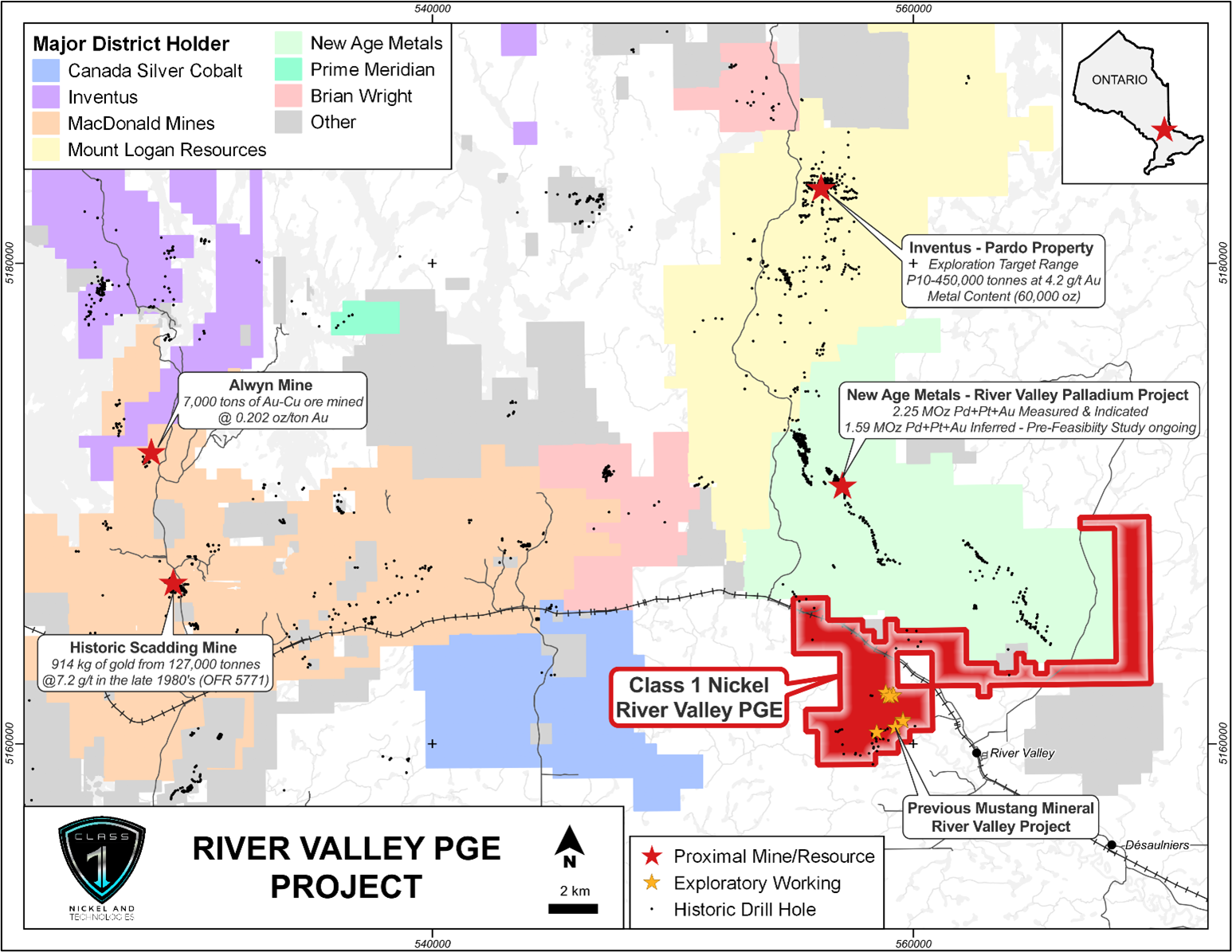Class 1 Nickel and Technologies Ltd. has announced the conclusion of the sample collection component of an exploration program that included 287 B-horizon soil geochemical sampling and 287 biogeochemical plant sampling at its River Valley PGE Project, which is situated about 100 km east of Sudbury, Ontario, Canada.
 Location of the River Valley PGE Project near the City of Sudbury, Ontario, Canada. Image Credit: Class 1 Nickel and Technologies Limited
Location of the River Valley PGE Project near the City of Sudbury, Ontario, Canada. Image Credit: Class 1 Nickel and Technologies Limited
The River Valley PGE Project is located in the townships of Crerar and Dana in the Sudbury Mining Division of northeastern Ontario, Canada. The project’s focal point is approximately 100 km east-northeast of Greater Sudbury.
The River Valley Palladium Project is an advanced PGE (palladium>platinum) site being developed by New Age Metals, located just south of the project.
The Company has chosen to characterize potential drilling targets using biogeochemical sampling methods, a less invasive approach than conventional approaches, to reduce the environmental impact.
In a less common method, samples of plants (tree twigs, bark, etc.) are collected at predetermined locations in a forest ecosystem, and they are then sent to a specialized lab for analysis. The goal of the analysis is to find PGE and 50 other pathfinder elements that could be concentrated in the plant.
The high solubility of plant tissues makes this approach an efficient tool to gauge soil mineral richness and utilize elemental concentrations to vector on new PGE targets.
The collected plant material is next heated to 480 °C, carbonized, digested in an acid (proprietary acid), and finally examined. ABG Exploration Inc. and GMY Inc. are the companies that designed and carried out biogeochemical surveys.
The company will conduct a more thorough examination within the project, focusing on wider target areas, if the initial tests are successful. Biogeochemistry + B-horizon soil geochemistry should increase the likelihood of supplying higher quality drill targets, decrease the total number of drilled sites, and thereby reduce the environmental impact of the program.
This is in addition to confirming the presence of pathfinder elements not always detected by other exploration methods.
Alexandr Beloborodov (P.Geo.), the company’s vice president of exploration, will be in charge of interpreting the geochemical data that has been gathered.
Biogeochemistry is a proven method of locating zones of mineralization. Respectful of the environment and less intrusive, it makes it possible to better specify locations to carry out drilling work and therefore to limit it to what is strictly necessary in order to preserve the forest ecosystem. This is one of the practices that Class 1 Nickel favors to help maintain its unwavering commitment to carry out exploration that respects the principles of sustainable development.
Alexandr Beloborodov, Vice President, Exploration, Class 1 Nickel and Technologies Ltd.
The two different geochemical survey results will be combined in the company’s exploration database for thorough interpretation and targeting to create high-priority drill targets.
About The River Valley PGE Project
The River Valley Intrusion’s gabbroic to anorthositic rocks, which form the subsurface of the River Valley PGE Project, offer an extremely potential target for PGE exploration (see, for example, Jobin-Bevans, 2004).
The majority of PGE mineralization in the RVI occurs along the intrusion’s margins (Contact-Style PGE-Cu-Ni) within the brecciated and sulfide-mineralized Marginal Series (Marginal and Inclusion-Bearing zones) (or Marginal Series), and these areas are the focus of exploration at the surface and in three dimensions using geophysical surveys like gravity, magnetics, and induced polarization.
Mustang Minerals Corp. (South Grid, Crerar Township) and Aquiline Resources Inc. (northwest of the Project and into Dana Township) have been conducting historical exploration work on the Project since 1999, focusing on PGE deposit through trenching, mapping, geophysics, and diamond drilling.
Targeting nickel-copper sulfide deposits, earlier exploration work was carried out by Falconbridge Nickel Mines Ltd (1965), Tomrose Mines Ltd. (1963–1966), and McIntyre Porcupine Mines Ltd (1956).
The PGE-Cu-Ni sulfide mineralization that has been potentially significant mineralization discovered to date on the Project is concentrated within an approximately 3-km trend of mineralized Breccia Unit (Marginal Series/Marginal Zone) along the southeast contact of the RVI in the southeast part of the Project, known as the “Crerar Trend.”
The Sudbury Basin is the second-largest supplier of nickel ore in the world, and Sudbury, Ontario is a significant mining, mineral processing, and metals recovery center (Ni-Cu-Co-PGE).